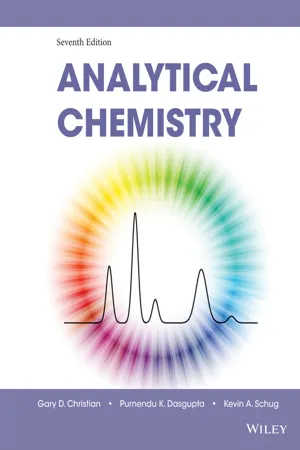Chemistry
Acid-Base Titration
Acid-base titration is a technique used to determine the concentration of an acid or base in a solution. It involves slowly adding a solution of known concentration (titrant) to the solution of unknown concentration (analyte) until the reaction between the two is complete. The point at which the reaction is complete, known as the equivalence point, is used to calculate the concentration of the analyte.
Written by Perlego with AI-assistance
Related key terms
1 of 5
10 Key excerpts on "Acid-Base Titration"
- eBook - PDF
Analytical Chemistry
A Toolkit for Scientists and Laboratory Technicians
- Bryan M. Ham, Aihui MaHam(Authors)
- 2024(Publication Date)
- Wiley(Publisher)
Titrimetric analysis is the process of measuring a substance of unknown concentration in a solution of interest via reaction with a standard that we have made that contains a known substance concentration. If we take a known weight or volume of our solid or solution of interest, we can calculate the concentration of the unknown from the measured use of our known concentration so- lution. Chemists call the standard solution the titrant solution. Analytical Chemistry: A Toolkit for Scientists and Laboratory Technicians, Second Edition. Bryan M. Ham and Aihui MaHam. © 2024 John Wiley & Sons, Inc. Published 2024 by John Wiley & Sons, Inc. Companion website: www.wiley.com/go/AnalyticalChemistry2e 10.2 REACTING RATIOS In a titration analysis, the reaction taking place is known with a predetermined stoichiometry. The analyst knows what com- pound is reacting with what compound and the moles of each. Suppose we have a compound “A” that is the titrant and a com- pound “B” that is our known substance of interest that we want to determine the concentration of. A simplified representation of the reaction is aA + bB → products (10.1) DERIVING THE TITRATION EQUATION 179 In the above reaction, a and b are the moles of reactants and are necessary to know to calculate concentrations. For example, the reaction of a titrant of dissolved silver (Ag + ) and chloride (Cl − ) in our test solution to produce the insoluble compound sil- ver chloride (AgCl) is represented as: Ag + (aq) + Cl − (aq) → AgCl(s) (10.2) where a = 1, b = 1, aq = aqueous (meaning the substance is in solution), and s = solid (meaning the substance is not in solu- tion). For the determination of sodium hydroxide with the titrant sulfuric acid, the reaction is: H 2 SO 4 + 2NaOH → Na 2 SO 4 + 2H 2 O (10.3) In this case, a = 1 and b = 2. 10.3 THE EQUIVALENCE POINT When we are performing titrations, it is most optimal if the reac- tion basically goes to completion in a very short amount of time. - Henry Freiser, Monika Freiser(Authors)
- 1992(Publication Date)
- CRC Press(Publisher)
Chapter 8 Titrations I B r0nsted Acids and Bases Nature of Titrations Titrimetry is an analytical process involving adding portions of a reagent in solution, called a titrant, to react, in a specific and well-defined manner, with a component of an analyte solution, until an exact equivalent (Le., when the titration reaction is exactly complete) of the reagent has been ad de d. This is called the equivalence point. In this respect, titr imetr ic analysis differs from most other types of analysis in which an excess of reagent is adde d. Polyfunctional species will lead to more than one equivalence point in a titration. In this respect, titr imetr ic analysis differs from most other types of analysis in which we add an excess of reagent. Titrimetric methods can be classified according to the type of chemical reaction involved, such as acid-base, precipitation, metal complex formation (complexo metric), oxidation-reduction, among others. In order for a useful, reliable titration to be achieved, the titration reaction must go to completion in a relatively rapid fashion and be free of any interfering side reactions. The substance used as titrant must be readily available in pure, stable form and be reasonable in cost. Further, it must be possible to readily detect the endpoint, the experimental approximation of the equivalence point, by suitable visual or instrumental ind icators. A visual indicator is generally a highly conjugated aromatic organic compound having the characteristic reactivity of the titration type (i.e ., it may be a weak acid, metal complexing agent, reductant, etc.) whose coupled forms (HIn/In, MInlIn, OxlRed) are highly and differently colored. The visual indication of the endpoint depends on observing in a nar row concentration range of the critical variable, the color change of the indicator from one form to the other.- eBook - PDF
- Gary D. Christian, Purnendu K. Dasgupta, Kevin A. Schug(Authors)
- 2020(Publication Date)
- Wiley(Publisher)
Differentiate between end point and equivalence point. 14. Explain the terms: (a) titration error, (b) indicator and (c) modified methyl orange. 15. The concentration of NaOH is 0.5 M. If 20 mL is needed to titrate 35 mL of acid, what is the concentration of acid? 0.875 M of acid (a) 0.0029 M of acid (b) 0.29 M of acid (c) 0.00875 M of acid (d) 16. What is the purpose of indicator in the solution with the unknown concentration? (a) It will show when there is enough acid in the solution. (b) It will show when the equivalence point is obtained. (c) It will show when there is enough base in the solution. 17. The equation of neutralization reaction between solutions of potassium hydroxide and hydrochloric acid is: (a) H + (aq) + OH - (aq) → H 2 O (b) KOH (aq) + HCl (aq) → H 2 O (l) + KCl (c) POH (aq) + HClO (aq) → H 2 O (l) + PClO (aq) (d) KOH (aq) + HCl (aq) → K 2 Cl (aq) + H 2 O (l) (e) KOH (aq) + HCl (aq) → K 2 Cl (aq) + H 2 O (l) + H + 18. 50 mL of 0.5 M barium hydroxide is required to fully titrate a 100 mL solution of sulfuric acid. What is the initial concentration of acid? 50 M (a) 0.5 M (b) 100 M (c) 0.25 M (d) 19. In a titration of a weak acid with strong base, what is the pH of the solution at the equivalence point? > 7 (a) < 7 (b) 7 (c) 0 (d) Pdf _Folio:2 99 300 CHAPTER 7 ACID–BASE TITRATIONS 20. Which of the following describes the equivalence point on a graph of pH versus the amount of titrant added to a solution? (a) The point with the lowest pH. (b) The point with the highest pH. (c) The point where the magnitude of the slope of the curve is greatest (d) the point where the magnitude of the slope of the curve is least. 21. After adding very large volume of titrant, asymptote in curves appears, the position of asymptote is determined by which of the following experimental parameters? (a) pH of the initial solution (b) Slope of the curve of titration curve (c) K a of initial solution (d) The pH of titrant 22. - eBook - PDF
- Gary D. Christian, Purnendu K. Dasgupta, Kevin A. Schug(Authors)
- 2013(Publication Date)
- Wiley(Publisher)
The titrations of weak acids or bases with two or more titratable groups and of mixtures of acids or bases are presented. The important Kjeldahl analysis method is described for determining nitrogen in organic and biological samples. What are some uses of acid–base titrations? They are important in a number of (Courtesy of Metrohm AG.) industries. They provide precise measurements. While manual titrations are tedious, automated titrators are often used that can perform titrations effortlessly and accurately. Acid–base titrations are used in the food industry to determine fatty acid content, acidity of fruit drinks, total acidity of wines, acid value of edible oils, and acetic acid content of vinegar. They are used in biodiesel production to determine the acidity of waste vegetable oil, one of the primary ingredients in biodiesel production; waste vegetable oil must be neutralized before a batch may be processed to remove free fatty acids that would normally react to make soap instead of biodiesel. Ammonia is very toxic to aquatic life; aquaria test for ammonia content. In the plating industry, boric acid concentration in nickel plating solutions is determined. In the metal industries, 281 282 CHAPTER 8 ACID–BASE TITRATIONS acid in etching solutions is determined. In the environmental arena, alkalinity or acidity of city and sewage water is determined. In the petroleum industry, the acid number of engine oil is determined, and acetic acid in vinyl acetate. In the pharmaceutical industry, sodium hydrogen carbonate in stomach antacids is determined. Acid–base titrations can be used to determine the percent purity of chemicals. The saponification value of carboxylic acids is used to determine the average chain length of fatty acids in fat, by measuring the mass in milligrams of KOH required to saponify the carboxylic acid in one gram of fat. - eBook - PDF
Oscillometry and Conductometry
International Series of Monographs on Analytical Chemistry
- E. Pungor, R. Belcher, L. Gordon(Authors)
- 2016(Publication Date)
- Pergamon(Publisher)
PART III Acid-Base Titrations This page intentionally left blank C H A P T E R 8 THE TITRATION OF MONOBASIC ACIDS AND BASES T H E conductivity of the solutions can be used to determine the end-point of titrations.The end-point appears as a break in the plots of conductivity change against amount of reagent added if the slope of the curve changes during titration. When making use of conductivity in connection with Acid-Base Titrations, it is first necessary to understand the changes occurring during titration. In this connection (as also in the next chapters), the principles of conductometry will be discussed first, since the oscillometric functions can readily be derived from them on the basis of the characteristic oscillometric function (the relation between the concentration and the measured phy-sical quantity). The basic reaction of Acid-Base Titrations, written in a general form, is: H+ + A - + M+ + O H - = H 2 0 + M+ + A~ (8.1 ) According to this equation, when an acid is titrated with a base, the quickly moving hydrogen ions are replaced by less mobile metal ions. Similarly, when titrating a base with an acid, the highly mobile hydroxyl ions are replaced by an anion of lower mobility. The product of the acid-base reaction is a salt. Taking this fact as a starting point, the titration curves can be constructed in a most convenient way. If, during the titration, the solution is not considerably diluted, the conductivity shows a linear increase until the end-point of the titration, as a consequence of salt formation. However, no more salt is formed after the end-point has been reached and the conductivity contribution of 125 126 OSCILLOMETRY AND CONDUCTOMETRY the salt remains constant on addition of further quantities of the reagent. The plot showing the conductivity contribution of the salt is the salt-line. At least one point of the titration curve — the equivalence point — is common to the salt-line. - eBook - ePub
- John Kenkel(Author)
- 2013(Publication Date)
- CRC Press(Publisher)
back titration is required. In this procedure, the analyte is consumed using excess titrant (the end point is intentionally overshot), and the end point is then determined by titrating the excess with a second titrant. Thus, two titrants are used, and the exact concentration of each is needed for the calculation.FIGURE 5.13 Illustration of a back titration.Figure 5.13 shows a graphic representation of a back titration using the titration curve of a strong acid titrated with a strong base to illustrate. The top arrow (point to the right) represents the amount of titrant added initially. It is apparent that this amount is beyond what was needed to reach the equivalence point, which as we discussed previously, coincides with the inflection point, the sharp increase in pH. To determine precisely how much was added in excess, this excess is titrated with a second titrant, as the left pointing arrow illustrates. We say we “come back” to the equivalence point after having gone beyond it. The difference between the total equivalents of the first titrant and the total equivalents of the second titrant is the number of equivalents that actually reacted with the analyte, represented by the darker shaded block in Figure 5.13 . It is this number of equivalents that is needed for the calculation. The calculation therefore uses the following equation derived from Equation PA.2 in Box 4.7 in Chapter 4 . This equation is given as Equation PA.3 in Box 4.7 .in which “BT” symbolizes the “back titrant.”% analyte =(5.18)× 100sample weight(×L T×N T−L BT×N BT)EW analyteIt may seem strange that we would ever want to perform an experiment of this kind. First of all, it would be used in the event of a slow reaction taking place in the reaction flask. Perhaps the sample is not dissolved completely, and the addition of the titrant causes dissolution to take place over a period of minutes or hours. Adding an excess of the titrant and back titrating it later would seem an appropriate course of action in that case. An example would be the determination of the calcium carbonate in an antacid tablet. The tablet and the analyte, often calcium carbonate, do not dissolve in water, but it does dissolve in a standard solution of HCl according to the following neutralization reaction: - eBook - PDF
- Paul Flowers, Klaus Theopold, Richard Langley, William R. Robinson(Authors)
- 2015(Publication Date)
- Openstax(Publisher)
We base our choice of indicator on a calculated pH, the pH at the equivalence point. At the equivalence point, equimolar amounts of acid and base have been mixed, and the calculation becomes that of the pH of a solution of the salt resulting from the titration. 822 Chapter 14 | Acid-Base Equilibria This OpenStax book is available for free at http://cnx.org/content/col11760/1.9 acid ionization acid ionization constant (K a ) acid-base indicator acidic amphiprotic amphoteric autoionization base ionization base ionization constant (K b ) basic Brønsted-Lowry acid Brønsted-Lowry base buffer buffer capacity color-change interval conjugate acid conjugate base diprotic acid diprotic base Henderson-Hasselbalch equation ion-product constant for water (K w ) leveling effect of water monoprotic acid neutral oxyacid Key Terms reaction involving the transfer of a proton from an acid to water, yielding hydronium ions and the conjugate base of the acid equilibrium constant for the ionization of a weak acid organic acid or base whose color changes depending on the pH of the solution it is in describes a solution in which [H 3 O + ] > [OH − ] species that may either gain or lose a proton in a reaction species that can act as either an acid or a base reaction between identical species yielding ionic products; for water, this reaction involves transfer of protons to yield hydronium and hydroxide ions reaction involving the transfer of a proton from water to a base, yielding hydroxide ions and the conjugate acid of the base equilibrium constant for the ionization of a weak base describes a solution in which [H 3 O + ] < [OH − ] proton donor proton acceptor mixture of a weak acid or a weak base and the salt of its conjugate; the pH of a buffer resists change when small amounts of acid or base are added amount of an acid or base that can be added to a volume of a buffer solution before its pH changes significantly (usually by one pH unit) range in pH over which the color change of an indicator takes place substance formed when a base gains a proton substance formed when an acid loses a proton acid containing two ionizable hydrogen atoms per molecule. - eBook - PDF
Chemistry
An Atoms First Approach
- Steven Zumdahl, Susan Zumdahl, Donald J. DeCoste, , Steven Zumdahl, Steven Zumdahl, Susan Zumdahl, Donald J. DeCoste(Authors)
- 2020(Publication Date)
- Cengage Learning EMEA(Publisher)
The pH curve is shown in Fig. 14.5. 608 CHAPTER 14 Acid–Base Equilibria Copyright 2021 Cengage Learning. All Rights Reserved. May not be copied, scanned, or duplicated, in whole or in part. Due to electronic rights, some third party content may be suppressed from the eBook and/or eChapter(s). Editorial review has deemed that any suppressed content does not materially affect the overall learning experience. Cengage Learning reserves the right to remove additional content at any time if subsequent rights restrictions require it. CRITICAL THINKING You have read about titrations of strong acids with strong bases, weak acids with strong bases, and weak bases with strong acids. What if you titrated a weak acid with a weak base? Sketch a pH curve and defend its shape. Label the equivalence point and discuss the pos- sibilities for the pH value at the equivalence point. 14.5 Acid–Base Indicators There are two common methods for determining the equivalence point of an acid–base titration: 1. Use a pH meter (see Fig. 13.7) to monitor the pH and then plot the titration curve. The center of the vertical region of the pH curve indicates the equivalence point (for example, see Figs. 14.1 through 14.5). 2. Use an acid–base indicator, which marks the end point of a titration by chang- ing color. Although the equivalence point of a titration, defined by the stoichiom- etry, is not necessarily the same as the end point (where the indicator changes color), careful selection of the indicator will ensure that the error is negligible. The most common acid–base indicators are complex molecules that are themselves weak acids (represented by HIn). They exhibit one color when the proton is attached to the molecule and a different color when the proton is absent. For example, phenol- phthalein, a commonly used indicator, is colorless in its HIn form and pink in its In 2 , or basic, form. The actual structures of the two forms of phenolphthalein are shown in Fig. - eBook - PDF
- William R. Robinson, Edward J. Neth, Paul Flowers, Klaus Theopold, Richard Langley(Authors)
- 2016(Publication Date)
- Openstax(Publisher)
We base our choice of indicator on a calculated pH, the pH at the equivalence point. At the equivalence point, equimolar amounts of acid and base have been mixed, and the calculation becomes that of the pH of a solution of the salt resulting from the titration. 788 Chapter 14 | Acid-Base Equilibria This OpenStax book is available for free at http://cnx.org/content/col12012/1.7 acid ionization acid ionization constant (K a ) acid-base indicator acidic amphiprotic amphoteric autoionization base ionization base ionization constant (K b ) basic Brønsted-Lowry acid Brønsted-Lowry base buffer buffer capacity color-change interval conjugate acid conjugate base diprotic acid diprotic base Henderson-Hasselbalch equation ion-product constant for water (K w ) leveling effect of water monoprotic acid neutral oxyacid Key Terms reaction involving the transfer of a proton from an acid to water, yielding hydronium ions and the conjugate base of the acid equilibrium constant for the ionization of a weak acid organic acid or base whose color changes depending on the pH of the solution it is in describes a solution in which [H 3 O + ] > [OH − ] species that may either gain or lose a proton in a reaction species that can act as either an acid or a base reaction between identical species yielding ionic products; for water, this reaction involves transfer of protons to yield hydronium and hydroxide ions reaction involving the transfer of a proton from water to a base, yielding hydroxide ions and the conjugate acid of the base equilibrium constant for the ionization of a weak base describes a solution in which [H 3 O + ] < [OH − ] proton donor proton acceptor mixture of a weak acid or a weak base and the salt of its conjugate; the pH of a buffer resists change when small amounts of acid or base are added amount of an acid or base that can be added to a volume of a buffer solution before its pH changes significantly (usually by one pH unit) range in pH over which the color change of an indicator takes place substance formed when a base gains a proton substance formed when an acid loses a proton acid containing two ionizable hydrogen atoms per molecule. - eBook - PDF
- Douglas Skoog, Donald West, F. Holler, Stanley Crouch, Douglas Skoog(Authors)
- 2021(Publication Date)
- Cengage Learning EMEA(Publisher)
Due to electronic rights, some third party content may be suppressed from the eBook and/or eChapter(s). Editorial review has deemed that any suppressed content does not materially affect the overall learning experience. Cengage Learning reserves the right to remove additional content at any time if subsequent rights restrictions require it. 310 CHAPTER 12 Principles of Neutralization Titrations Chapter 12 Summary • Using standard solutions • Uses and properties of acid-base indicators • Minimizing titration errors • Various types of Acid-Base Titrations of strong and weak acids and bases • The effect of reagent concentration on the shapes of titration curves • Methods to select an indicator • Methods to construct titration curves • The effect of equilibrium constants on the shapes of titration curves • Method to construct a titration curve using a master equation • Changes in solution composition as titrations progress • Using derivative and Gran plots to determine equivalence points Search online for the web document, “The Fall of the Proton: Why Acids React with Bases” by Stephen Lower. This document explains acid-base behavior in terms of the concept of proton-free energy. How is an Acid-Base Titration described in this view? In a titration of a strong acid with a strong base, what is the free energy sink? In a complex mixture of weak acid-base systems, such as blood serum, what happens to protons? ON THE INTERNET Key Terms Acid-base indicators, p. 289 Gran plot, p. 308 Standard solutions of acids and bases, p. 289 Strong acid/strong base titrations, p. 293 Titration curves, p. 298 Titration errors, p. 292 Transition range, p. 292 Weak acid/strong base titrations, p. 298 Important Equations indicator pH range pK a 61 pK w pH 1 pOH Questions and Problems *12-1. Why does the typical acid-base indicator exhibit its color change over a range of about 2 pH units? 12-2. What factors affect end-point sharpness in an Acid-Base Titration? *12-3.
Index pages curate the most relevant extracts from our library of academic textbooks. They’ve been created using an in-house natural language model (NLM), each adding context and meaning to key research topics.









